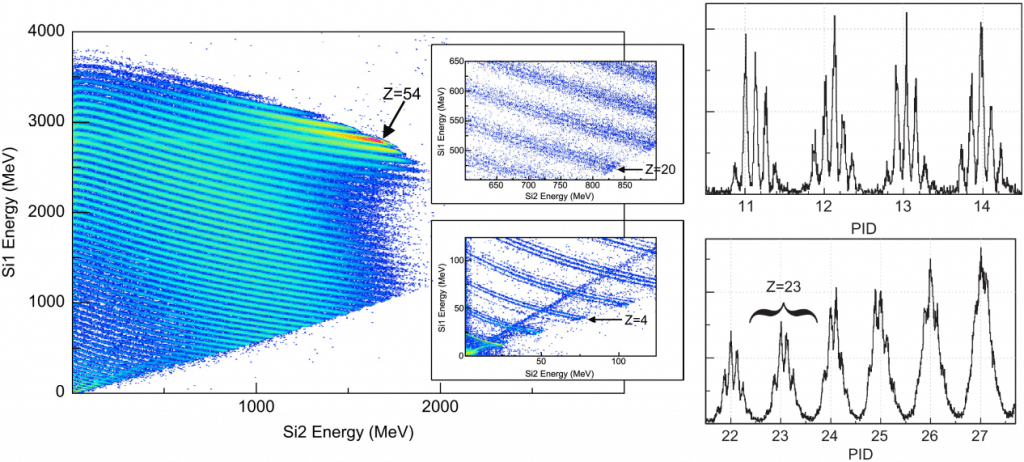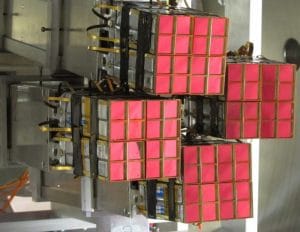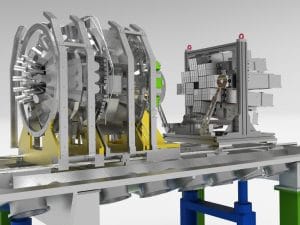- Homepage
- >
- Scientists
- >
- GANIL-SPIRAL 2 facilities
- >
- Instrumentation
- >
- FAZIA
- Accelerators
- Available beams
- Experimental areas
- ARIBE
- D1
- D2
- D3-D6 / LISE
- D5
- DESIR
- G1 / VAMOS
- G2
- G3
- G4
- IRRSUD
- LIRAT
- NFS – Neutrons for Science
- S3 – Super Separator Spectrometer
- Instrumentation
- ACTAR TPC
- AGATA
- CHATEAU DE CRISTAL
- DIAMANT
- EXOGAM / EXOGAM2
- FAZIA
- INDRA
- LPCTrap
- MORA
- MUST2
- NEDA
- PARIS
- REGLIS3
- S3 Low Energy Branch
- SIRIUS
FAZIA
Presentation
The goal of the European FAZIA Collaboration is the design of a new-generation 4π detector array for heavy-ion collisions with greatly enhanced isotopic identification capabilities. The determination of the charge and mass of all reaction products is essential to advance knowledge of topics such as the density dependence of nuclear symmetry energy, in-medium isovector transport properties of nuclear matter, and EOS modification due to cluster effects at very low densities.
As a first step towards this goal, the FAZIA block is the result of more than 10 years of R&D into pushing the limits of the ΔE-E technique with highly uniform (in thickness and doping) silicon detectors, refining Pulse-Shape Analysis (PSA) techniques for identification in a single detector, and developing a dedicated on-board electronics comprising both analogue (pre-amplifier) and digital stages.
|
|
|
The first commissioning experiment with the first 4 FAZIA blocks were carried out at LNS Catania in 2015. During 2015-2018 4 further experiments were performed with either 4 or 6 blocks. The mass and charge identification performance of these blocks is exceptional and unique: for fragments punching through the first Si(300µm) detector, isotopic resolution is achieved up to Z=25, while the Z & A of slower fragments stopping in the first silicon is obtained up to Z=20. All heavier fragments can be identified in Z.
The next step for FAZIA is the coupling of 12 blocks (the so-called FAZIA demonstrator array) with the INDRA multidetector at GANIL. For this the most forward rings of INDRA (up to 14 deg. polar angle) have been removed in order to be replaced by a wall of FAZIA blocks at forward angles. This will provide complete mass and charge identification of both quasi-projectile and mid-rapidity (neck) fragments in FAZIA, while the remaining INDRA rings completing the 4π coverage will allow the accurate reaction mechanism selection which is essential for comparison with theoretical predictions. This set-up will be ready for a first experiment approved by the GANIL PAC in Spring 2019, and further experiments should be performed in the coming years. A future possibility is to move the FAZIA demonstrator to the LISE beamline in order to benefit from high energy exotic beams with N/Z ratios impossible to reach using the stable beams of the GANIL cyclotrons.

Fig. 3: FAZIA identification capabilities for particles punching through the first 300µm-thick Si detector: (left) DE-E matrix for reactions with Xe projectiles; (right) PID (particle identification number) spectra showing resolved mass peaks for different Z values (adapted from [2])
Publications
[1] “Particle identification using the ΔE-E technique and pulse shape discrimination with the silicon detectors of the FAZIA project”, S. Carboni et al, Nuclear Instruments and Methods in Physics Research A664 (2012) 251
[2] “Isospin transport in 84Kr+ 112,124Sn collisions at Fermi energies”, S. Barlini et al (FAZIA collaboration), Physical Review C 87 (2013) 054607
[3] “The FAZIA project in Europe: R&D phase”, R. Bougault et al (FAZIA collaboration), European Physical Journal A50 (2014) 47
[4] “Front end electronics for the FAZIA experiment”, F. Salomon et al, Journal of Instrumentation 11 (2016) C01064
[5] “New semi-automatic method for reaction product charge and mass identification in heavy-ion collisions at Fermi energies”, D. Gruyer et al, Nuclear Instruments and Methods in Physics Research A 847 (2017) 142
[6] “Isotopic identification using Pulse Shape Analysis of current signals from silicon detectors: Recent results from the FAZIA collaboration”, G. Pastore et al (FAZIA collaboration), Nuclear Instruments and Methods in Physics Research A860 (2017) 42
Collaboration
GANIL
INFN
CEA
CNRS
INFN
Università degli studi Firenze
LPC Caen
Ensicaen
Université de Caen
IPNO
LNS
Contact (GANIL)
Scientific coordinator: John Frankland – john.frankland@ganil.fr
More information: http://fazia.in2p3.fr/?lang=en


